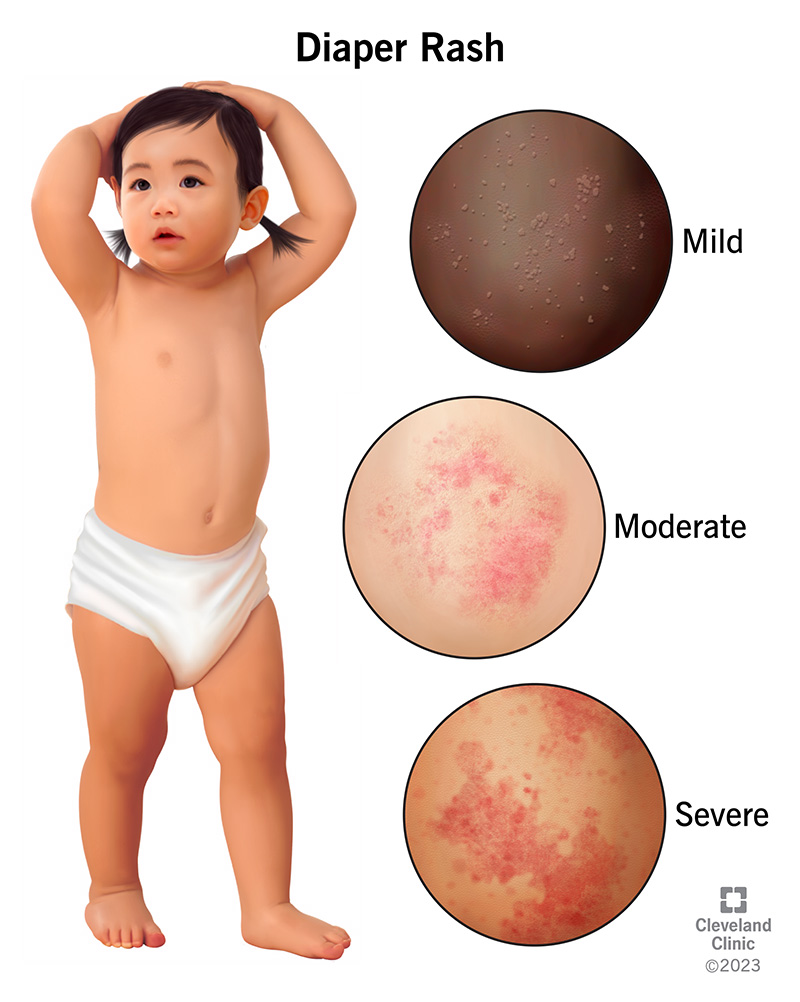Diaper rash is any rash that affects your baby’s diaper area — their buttocks, genitals or thighs. Diaper rash is the most common skin condition in young infants. Mild cases usually go away with simple home treatment within a few days. More severe diaper rash may need medical treatment from your baby’s healthcare provider.
Advertisement
Cleveland Clinic is a non-profit academic medical center. Advertising on our site helps support our mission. We do not endorse non-Cleveland Clinic products or services. Policy

A diaper rash is any rash that forms in your baby’s diaper area. In mild cases, the skin may be red and tender. A more severe diaper rash may have painful, open sores. Mild cases clear up within three to four days with home treatment. More severe cases may need medical treatment. Diaper rashes are the most common skin condition seen in young infants.
Advertisement
Cleveland Clinic is a non-profit academic medical center. Advertising on our site helps support our mission. We do not endorse non-Cleveland Clinic products or services. Policy
Diaper rash types include:
Diaper rash is very common. More than half of babies between 4 and 15 months of age will have a diaper rash at least once in a two-month period.
In mild cases, your baby may have slightly reddened skin around their buttocks, genitals and thighs. The area may be warm to the touch. The rash may be just a few spots, or it may cover the entire diaper area.
In more severe cases, the rash may include painful, open blisters or sores. If it gets infected, the rash may turn bright red and the skin around the area may get swollen.
Advertisement
Many different things can cause diaper rash, including:
When skin stays wet for too long, it starts to break down. Rubbing wet skin damages it more easily. Moisture from a soiled diaper can harm your baby’s skin and make it more prone to chafing. When this happens, a diaper rash may develop.
Diaper rash occurs more often when your baby:
Your baby’s healthcare provider can diagnose diaper rash by looking at it. However, you may not need to seek medical treatment for a diaper rash. You can usually treat the condition at home.
The first step in diaper rash treatment is keeping the area as clean and dry as possible. Change wet or soiled diapers right away. This helps cut down on how much moisture is on your baby’s skin.
Gently clean your baby’s diaper area with water and a soft washcloth. You may also use disposable diaper wipes, but sometimes rubbing the area should be avoided to prevent worsening irritation. Avoid wipes that contain alcohol and fragrance. Use soap and water only if your baby’s poop doesn’t come off easily. If your baby’s rash is severe, use a squirt bottle of water so you can clean and rinse without rubbing.
Pat dry; don’t rub. Allow the area to air-dry fully.
Apply a thick layer of protective diaper rash cream or ointment. The best diaper rash creams contain zinc oxide or petroleum jelly. These ointments are usually thick and don’t have to be completely removed at the next diaper change. Remember, heavy scrubbing or rubbing will only damage your baby’s skin more.
Don’t make your baby’s diaper too tight, especially overnight. Keep their diaper loose so the wet and soiled parts don’t rub against their skin as much.
You may see diaper rash remedies on the internet that include using household ingredients such as baking soda or cornstarch. But you want to be careful what you put on your baby’s broken skin. Certain products can cause more irritation or even lead to an infection. Stick with store-bought diaper rash creams to get rid of diaper rash.
Advertisement
Mild diaper rashes typically go away with home treatment within three to four days. More severe cases may require treatment with antibiotics or antifungals. With these medications, your baby’s diaper rash may take a week or longer to clear up.
There are many ways you can prevent diaper rash, including:
Diapers are made of either cloth or disposable materials. You can wash cloth diapers after they get soiled and use them again. You must throw away disposable diapers after each use.
Research suggests that diaper rash is less common with the use of disposable diapers. However, what’s more important than the type of diaper is how often it’s changed.
Whether you use cloth diapers, disposables or both, always change diapers as needed to keep your baby clean, dry and healthy.
Sometimes a diaper rash needs medical attention. Talk with your baby’s healthcare provider if:
Advertisement
You may have questions about diaper rash for your baby’s healthcare provider. Some questions you may want to ask include:
Diaper rash is the most common skin condition in babies. To prevent it, make sure to keep your baby clean and dry, and change their diaper frequently. Young infants have very delicate skin. Despite your best efforts, chances are that your baby will end up with diaper rash at least once. Fortunately, home treatment should clear it up within a few days. If it’s not going away, contact your baby’s healthcare provider for medical care.
Advertisement
As your child grows, you need healthcare providers by your side to guide you through each step. Cleveland Clinic Children’s is there with care you can trust.

Last reviewed on 03/20/2023.
Learn more about the Health Library and our editorial process.